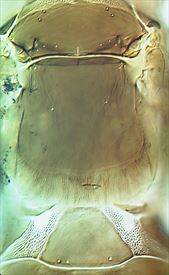Distinguishing features
Both sexes micropterous. Although similar in structure to P. orarius the ocelli are developed; antennal segment IV with 2 large sense cones and 1 small one; wing lobe longer than in orarius, with 3 sub-basal setae; pelta subquadrate; tergite VII with no long submedian, submarginal setae; tergite VIII posteroangular setae blunt; foretibial tubercle apparently smaller.
Male similar to female, but slightly smaller; fore tarsal tooth larger.
Related species
The genus Podothrips comprises 31 described species, mainly from the Old World tropics. In Australia, 11 species are recognised (Mound & Minaei, 2007), of which 10 are presumably endemic to that continent. Two species are known from New Zealand, both of them only from micropterae. The relationships of these two species are not clear (Mound & Walker, 1986), but orarius has only 2 sense cones on antennal segment IV whereas turangi has 3 sense cones on that segment.
Biological data
Collected from Poa and Chionochloa tussock, this thrips is likely to be predatory on scale insects that live on Poaceae.
Distribution data
Known only from New Zealand (TO).
Family name
PHLAEOTHRIPIDAE, PHLAEOTHRIPINAE
Species name
Podothrips turangi Mound & Walker
Original name and synonyms
Podothrips turangi Mound & Walker, 1986: 72
References
Mound LA & Minaei K (2007) Australian insects of the Haplothrips lineage (Thysanoptera – Phlaeothripinae). Journal of Natural History 41: 2919–2978.
Mound LA & Walker AK (1986) Tubulifera (Insecta: Thysanoptera). Fauna of New Zealand 10: 1–140.


